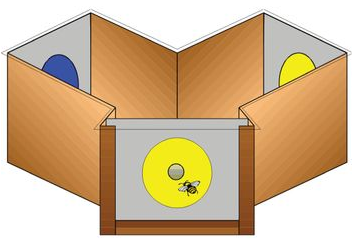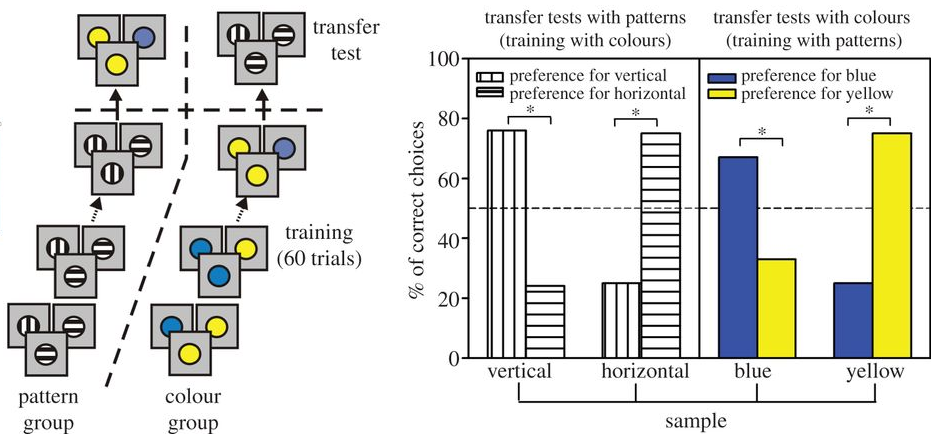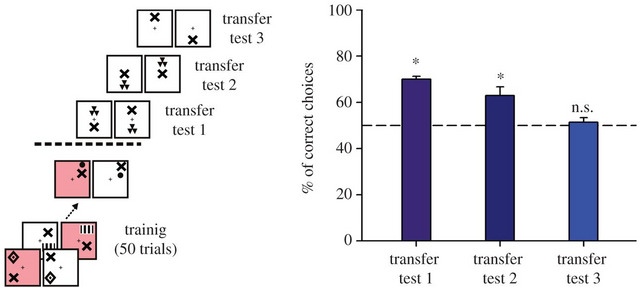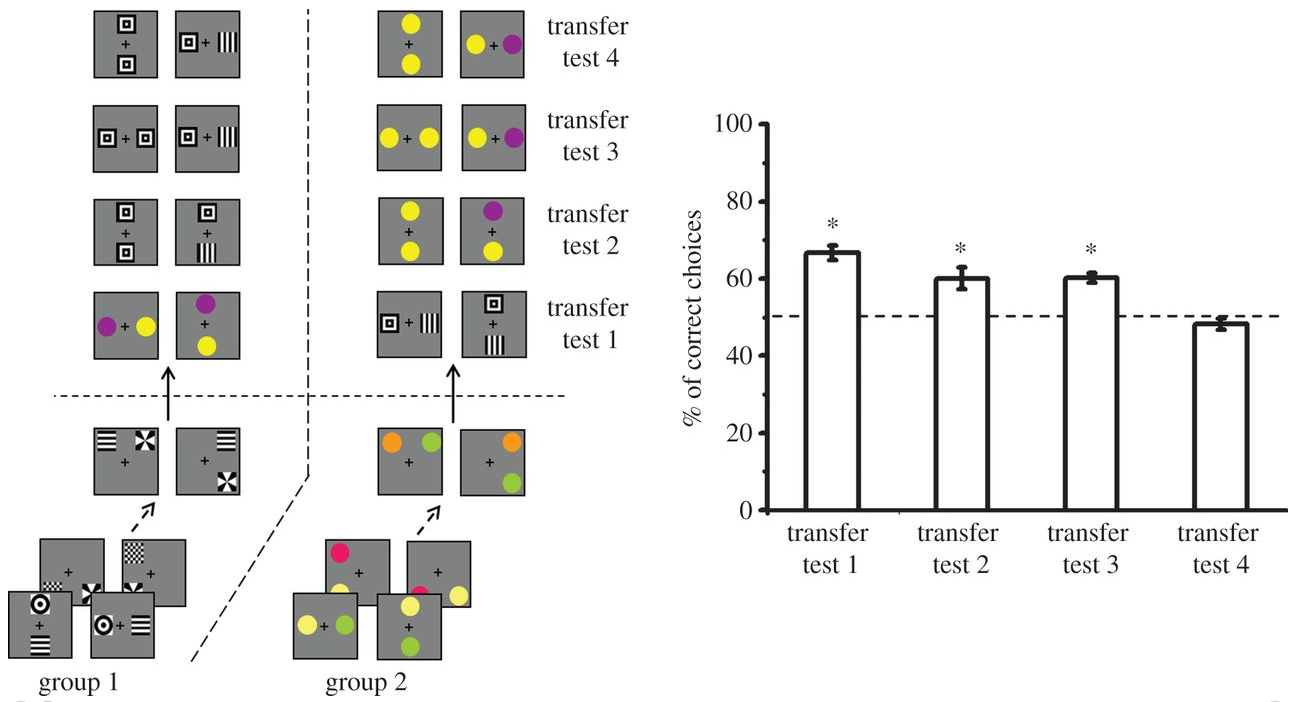Intelligence of insects, part II
While in part I[1] I described the 'waggle dance' and some interesting facts about the bee brain, this time I will present amazing examples of intelligent insect behavior.
Research by professor Martin Giurfa and his team about the ability of the bee brain of handling abstract concepts.
The results presented in "Conceptual learning by miniature brains"[2] may not appear to be the most spectacular findings in this field, but the performance ot the task has been done very thoroughly with well documented and presented outcomes. That's the reason why the biggest part of this article is dealing with it.
Structure of the mazes.
The scientists trained bees to enter an Y-maze whose entrance showed a certain symbol. In the maze two short ways lead to two other entrances where one of them showed the same symbol like the main entrance (see image on the right)[2]: |

|
The concept of sameness.
The idea was to test if the bees would understand the concept of 'sameness'. The insects were only rewarded with sucrose if they chose that branch of the maze showing the same color like the entrance (or reversed: other bees had to learn to chose the opposite color). The same tests have been executed by utilizing different patterns (with horizontal or vertical lines) instead of colors.
Furthermore, then bees trained with colors had to solve the pattern problem and reversed. They had no experience with the new task but had already learned to choose the same symbol (be it color or pattern) which they saw at the entrance.
(Earlier studies already had shown that apart from visual stimuli bees are also able to learn based on olfactory conditioning, too.[3])
Below in image a) on the left side you see how bees trained with patterns had to make a transfer test to solve an analogous task with colors, while bees trained with colors had to solve a pattern test.
In image b) on the right side you see the results: in spite of the new situation more than 70 % of the bees trained with colors also chose the correct pattern (and reversed).
|
|
|

Spatial concepts.
Similarly the scientists tested if bees not only understand the concept of sameness but also spatial ones like right, left, above and below.
For that reason the insects got trained to choose visual stimuli presented above or below a horizontal bar to be rewarded. In a transfer test the stimuli were changed to verify if the bees really understood the concept of above and below instead to just remember the patterns itself.
However, in this experiment all stimuli always were located in the same area (either in the upper or lower part) of the visual field. "... instead of learning a conceptual relationship, bees could have simply relied on the statistic distributions of images, which are different for the two problems ..." the researches write. To avoid that problem in a second experiment two distinguishable symbols were used, one serving as the target and one as the referent, where the target differed from trial to trial. The bees had to learn always to chose the branch of the maze where the target was in a position above (respectively below) the referent, like you can see in image c) below on the left side, where the cross is the referent and the other symbol the target. For example the pink colored visual fields were to train bees to learn that the target is always above the reference.
Especially interesting was "transfer test 3" because the bees had to choose even if the target was absent. One could have guessed they would have chosen the visual field on the left side, because the referent symbol was in a higher position, but the bees chose randomly (results can be found in image d) on the right side). That means they really understood that only the position of the target in relation to the referent did matter - and without target no reasonable decision was possible.
|
|
|

Combining two concepts.
Let's finally check image e) below on the left side. Now it is getting really complicated and - be honest - are you sure you would beat the bees doing these tests? :-) The insects had to master two concepts simultaneously: one based on spatial relationships (right, left, above and below) and the other on difference.
|
|
|

The bees had to distinguish visual patterns consisting of two symbols in a certain spatial relationship (both were either horizontally beside each other or vertically above each other). In addition they had to learn that the symbols belonging to one pattern were always different (concerning color or shape). To get rewarded the bees had to chose patterns with the correct spatial orientation and two different symbols (in transfer test 1 they got presented unknown symbols, but nevertheless had to recognize if they were different from each other or not and had the correct spatial orientation).
If the bees had to choose between patterns which fulfilled only one of the two criteria (for example two different symbols but wrong spatial orientation; transfer tests 2 - 3) and patterns which fulfilled none, they preferred the former ones.
If they had the choice between correct spatial orientation but identical symbols or wrong spatial orientation and different symbols they showed no preference (transfer test 4) which means that they equally weighted both criteria.
You should be aware that the images b), d) and f) which are showing the results of the study are about the difficult transfer tests only, where the bees got presented with unknown symbols or conflicting situations. Considering that the results are amazingly good.
As the description of the study above has become quite extensive already let me present some other findings in a more condensed way. :)
Interesting bee interview with Prof. Dr. Randolf Menzel.
In a very interesting interview with the "ZEIT MAGAZIN"[4] the famous bee researcher Prof. Dr. Randolf Menzel confirms that bees actually know how to count or at least have an idea about sets: he trained bees to fly over three arranged tents to find sucrose after the last one. Even if he changed the distance between the tents the bees always were seeking for food exactly after they had overflown the third tent. Actually nowadays already numerous studies were made about "counting" in insects.[5]
In part I[1] I already described how the 'waggle dance' works. If by means of this 'symbolic language' a bee knows how two find the locations of two different food sources according to Menzel one can observe a really amazing behavior: if the bee reaches one of the places and notices that there is no food anymore one would expect it to fly back home and to start out from there for the second food source. Instead of that it calculates the direct way from the first to the second food source even if it only has learned how to reach both sources from its home as starting point! (Imagine a little girl wanted to visit a friend which it not at home - probably she would go back home again first, before visiting another friend ... she wouldn't find the direct way from friend to friend like a bee ...) Menzel is convinced that similar like mammals bees have a map available in theirs heads and in addition associate different informations with each other like for example the memories what other bees have told them by their 'waggle dances'.
Another part of the interview is about if we can speak about different 'bee cultures' because different bee colonies are 'speaking' different dialects and don't understand 'waggle dances' of members of other colonies. However, instead of pure 'cultural' also genetical reasons may play a role here.
Finally he mentions that like us bees are sleeping to improve their memory. He and his colleagues have observed that the more complex their test trials are the longer the bees need to sleep. If they are also dreaming? Nobody knows. :-)
Amazing observations of J. L. Gould.
In the book "Haben Tiere ein Bewusstsein?"[6] V. Arzt and I. Birmelin mention an astonishing experiment by J. L. Gould, a biologist working at Princeton University. He installed a little boat just in the middle of a lake and arranged a food source on it. Then he placed a bee (which had been marked before) on the source. As soon as this bee had reached the bee-hive it tried by 'waggle dancing' to convince the other bees to fly to the food source, too. Amazingly nearly no other bee payed much attention. It appears as if they didn't believe a food source could exist in the middle of a lake. By changing the position of the boat the scientist tried to verify his guess, and indeed other bees only got interested in the food source when the little ship was placed very near to the shore.
His only other explanation apart from just admitting that bees may be able to think logically was that the scout coming from the sea may have smelled of water. Therefore he tried a final 'trick'. At night, when most bees were sleeping he changed the position of the bee-hive near to a field surrounded by trees, similar like the lake and placed the food source in the middle of the grassland (in the same distance from the bee hive like before). Scouts which were still outside coming back from the food source obviously couldn't smell of water anymore. However the bees inside the bee-hive still weren't aware of the change of location. Again they didn't react to the 'waggle dance' of the incoming scouts because in their imagination they were still coming from the middle of a lake.
Arzt and Birmelin describe another stunning experiment of J. L. Gould in their book: every day he changed the position of a mobile food source by the same amount, and of course the bees always found it again. Amazingly after a while the bees already knew in advance where the food source would be placed and already waited impatiently for it! But that's not all. Gould made the arrangement more complicated and instead to change the position of the food source by the same amount, each day he multiplied the new distance by the factor 1.25. Nevertheless after a while the bees understood this pattern and waited again in advance at the correct position!
I hope you had some fun reading, but as this article got already much longer than initially planned I really have to finish here (but if time allows I may add part III in future).
Sources:
- https://steemit.com/science/@jaki01/intelligence-of-insects-part-i
- http://rspb.royalsocietypublishing.org/content/280/1772/20131907
- http://www.nature.com/nature/journal/v410/n6831/full/410930a0.html
- http://www.zeit.de/zeit-magazin/2015/02/bienen-forschung-randolf-menzel
- http://journal.frontiersin.org/article/10.3389/fpsyg.2013.00162/full
- Arzt, Volker / Birmelin, Immanuel. Haben Tiere ein Bewusstsein?. Munich: C. Bertelsmann Verlag, 1993.
Wow, amazing article, amazing topic and amazing insight presented here. Congratulations, @jaki01.
Yes, even if the amount of time I spend on articles like this one is never compensated by the reward (at least compared with much faster written articles, for example about travel, photography or chess ...), but at least the content is very interesting in my opinion and saved on the blockchain now. :-)
It is strange but fascinating to think that insects can be trained, almost in a similar way to dogs or other household pets. I feel I have been vastly underestimating the intelligence of bees and their capacity for learning. Really interesting stuff, reminds me somewhat of Antman where all the ants are trained and controlled with brainwaves.
Wow..
Great work.!!
Thanks for sharing my friend @jaki01
Resteem 😊
@jaki01..upvoted
I heard bees can be used to treat somr dangerous diseases!.,how true is this rumour?
Give me a link concerning these rumors, please, and i will tell you my opinion about it. :)
@jaki01 ,my source is not from the internet,my cousin had muscular distrophy and we were advised to use bees as a form of treatment because physiotherapy which was been used to maintain my cousin condition at the time became more less efficient and her situation was getting worse...the suggestion was from a doctor at the physiotherapy clinic and he was transferred shortly after informing us about bee treatment. ..since then my cousins parents have set a blind eye at bee treatment which is why am curious to know if its actually possible or not
Indeed scientists are researching concerning the effects of substances (like apamin) contained in bee venom against several diseases like for example muscular dystrophy.
Tnx a lot for this information @jaki01. ...i really appreciate,may God bless u for ur kindness and make u more knowledgeable
I think bees do have high intelligence, as we can see from their beautiful nests, a combination of hexagonal shapes. It really an amazing geometric
The difficulty is often to differentiate between real intelligent acting on the one hand and intelligent looking but inherent and instinctive behavior on the other hand ...
When it comes to hexagonal shapes, do you know about this study that demonstrated how the bees actually make a circle shape and then it transforms into a hexagon without bee involvement? Any thoughts on it?
Found your post fascinating, thank you for writing it.
Amazing ... I didn't know about this study, thanks for mentioning it!
Yes.. insects instinctive behavior especially ants and bees are very interesting. In term of their social life, much can be learned. While in other hand, viewed from the science side, it turn out many more interesting things. It was amazed to know that the bees can be trained. Thank you for sharing this knowledge :)
intelligence is on another level here thanks for sharing it man resteemed it i think many people need to see this
@jaki01 got you a $1.54 @minnowbooster upgoat, nice! (Image: pixabay.com)
Want a boost? Click here to read more!
After reading this post, bees amaze me more. I never thought they are that smart. I remember I once read my children's book about bees and it mentioned about the waggle dance. It turns out they are able to do more than that. Thanks @jaki01, now I know more about them.
You got my vote and a resteem :]
Thanks! :)
Interesting information! Are the bees most intelligent among insects? Thanks for the information.
At least their brains are amongst the biggest insect brains (check part I). Ants have rather big brains as well in relation to their body size.
Part II of this series was very interesting, too!
I will check part 1.